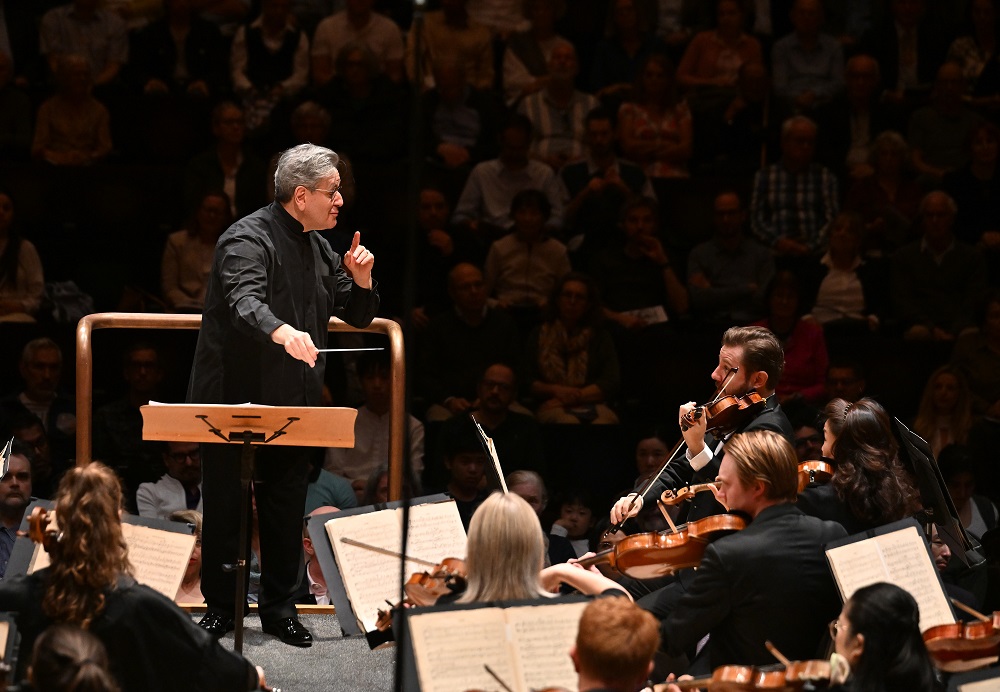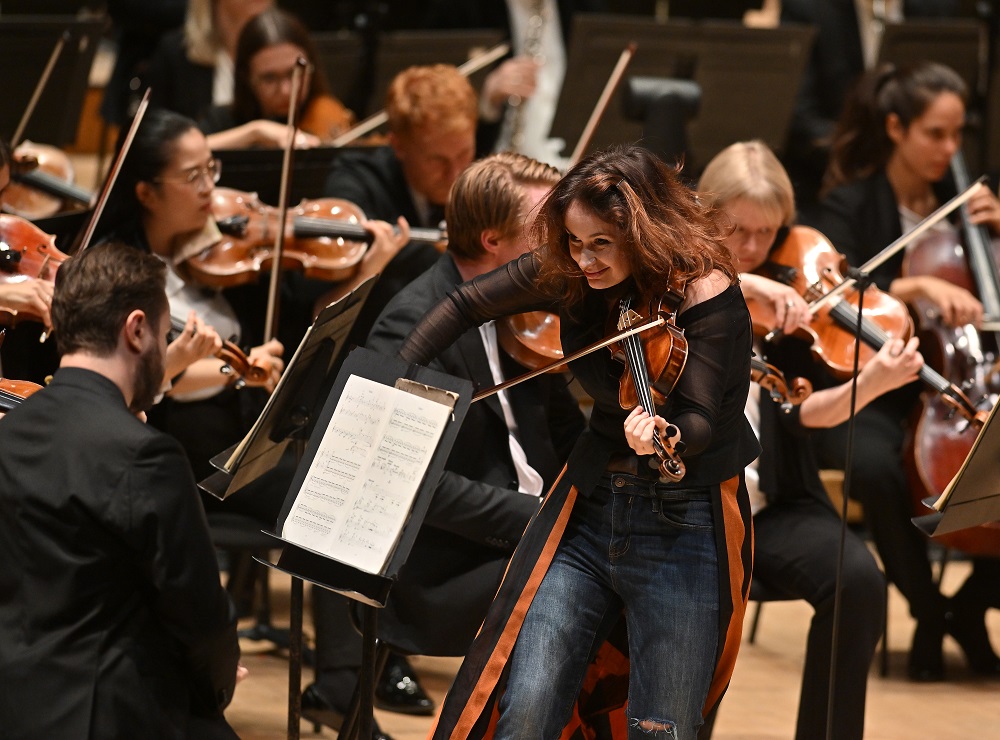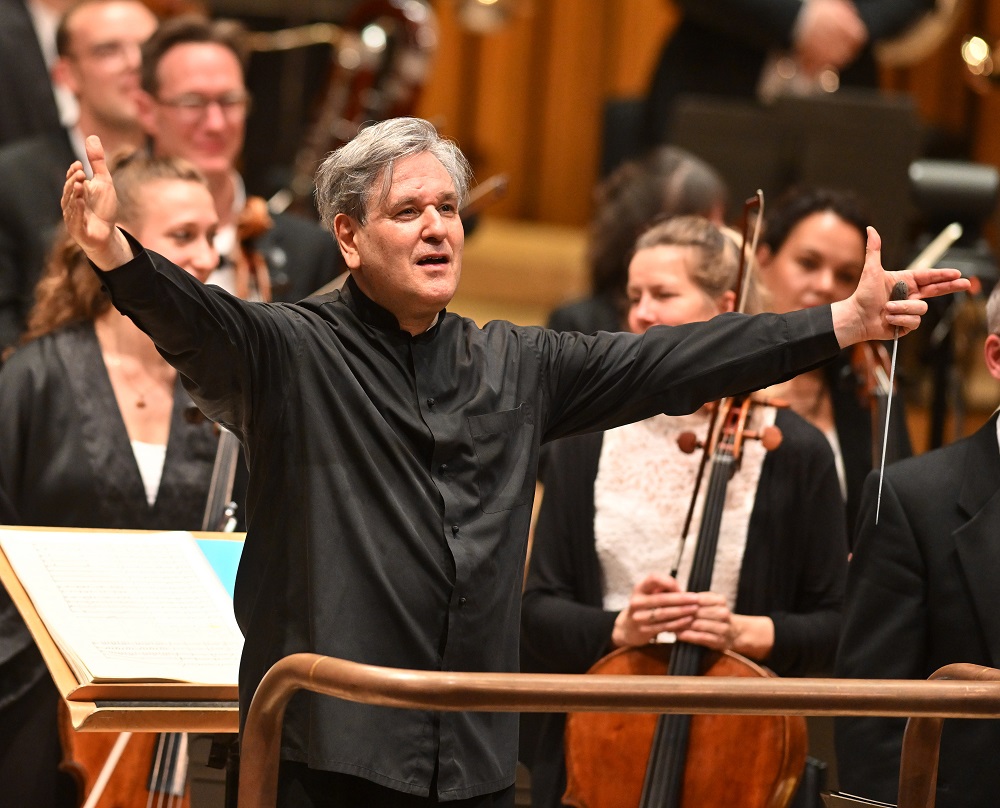Kopatchinskaja, LSO, Pappano, Barbican review - dancing on the volcano | reviews, news & interviews
Kopatchinskaja, LSO, Pappano, Barbican review - dancing on the volcano
Kopatchinskaja, LSO, Pappano, Barbican review - dancing on the volcano
Fazil Say’s Scheherazade whirls between cataclysmic Ravel and Rachmaninov
Poetry came an honourable second to sharp rhythms and lurid definition in this choreographic poem of a concert. You don’t get more tumultuous applause after an opener than with Ravel’s La Valse played like this. Vienna may have nearly collapsed after World War One, but the Scheherazade of Fazil Say’s 1001 Nights Violin Concerto lives to see a bright dawn, and Rachmaninov cries “Alliluya’ to whirling demons in his swansong Symphonic Dances.
Once again, there’s no doubt that the London Symphony Orchestra has made the right choice in Antonio Pappano, this season titled its Music Director Designate. The clear intentions still made magic at the start of the Ravel – all pointillist details emerging clearer than ever in what are usually the mists out of which the dancing couples emerge in La Valse; the haze was confined to the violins’ harp-girt swooning. Big chords landed with absolute precision; the nightmare was almost too entertaining to horrify, but maybe that was Ravel’s intention. (Pictured below: Pappano signalling to last night's leader, Andrej Power.)
Then again, Rachmaninov did write this as a homage to the sumptuous strings and virtuosity of the Philadelphia Orchestra; the LSO duly emulated that total classiness, and Pappano knows how to make instruments sing, as they did collectively after saxophonist Simon Haram's soulful cue at the heart of the first dance. The central Valse Triste had exactly the right volatility; the final battle at hell’s gates was razor sharp, and Pappano allowed the habitual tam-tam resonance some seconds after the collective cut-off (in the score, it gets just a quaver more, but the lingering is supremely evocative).
Showpiece with atmosphere is also how best to describe not only the performance but also the work in the case of Fazil Say’s Violin Concerto (1001 Nights in the Harem). Say as live-wire pianist started a duo partnership with that most vivid and volatile of violinists Patricia Kopatchinskaja in 2004 and composed this very pictorial work for her, which she premiered with commissioner the Lucerne Symphony Orchestra in 2007. Though the name of the tale-teller, Scheherazade, isn’t even mentioned in the notes, it must be she whom Kopatchinskaja impersonates (though not exclusively, as we’ll see). 
To see our very physically expressive soloist reacting so vibrantly to her fellow musicians – above all Neil Percy, sounding so idiomatic on Turkish drums, surely deserving a credit – inevitably revived memories of the equally collegial work of Baiba Skride with the National Symphony of Ireland in a much greater concerto, Bernstein’s Serenade, only two days earlier. Both violinists are top communicators, and so is Say: the unashamed populist streak is preferable to John Adams’ unfathomable notespinning in his second and much less effective violin concerto (or “symphony for violin and orchestra”) Scheherazade.2. 
rating
Explore topics
Share this article
The future of Arts Journalism
You can stop theartsdesk.com closing!
We urgently need financing to survive. Our fundraising drive has thus far raised £49,000 but we need to reach £100,000 or we will be forced to close. Please contribute here: https://gofund.me/c3f6033d
And if you can forward this information to anyone who might assist, we’d be grateful.

Subscribe to theartsdesk.com
Thank you for continuing to read our work on theartsdesk.com. For unlimited access to every article in its entirety, including our archive of more than 15,000 pieces, we're asking for £5 per month or £40 per year. We feel it's a very good deal, and hope you do too.
To take a subscription now simply click here.
And if you're looking for that extra gift for a friend or family member, why not treat them to a theartsdesk.com gift subscription?
more Classical music
 Lammermuir Festival 2025, Part 2 review - from the soaringly sublime to the zoologically ridiculous
Bigger than ever, and the quality remains astonishingly high
Lammermuir Festival 2025, Part 2 review - from the soaringly sublime to the zoologically ridiculous
Bigger than ever, and the quality remains astonishingly high
 BBC Proms: Ehnes, Sinfonia of London, Wilson review - aspects of love
Sensuous Ravel, and bittersweet Bernstein, on an amorous evening
BBC Proms: Ehnes, Sinfonia of London, Wilson review - aspects of love
Sensuous Ravel, and bittersweet Bernstein, on an amorous evening
 Presteigne Festival 2025 review - new music is centre stage in the Welsh Marches
Music by 30 living composers, with Eleanor Alberga topping the bill
Presteigne Festival 2025 review - new music is centre stage in the Welsh Marches
Music by 30 living composers, with Eleanor Alberga topping the bill
 Lammermuir Festival 2025 review - music with soul from the heart of East Lothian
Baroque splendour, and chamber-ensemble drama, amid history-haunted lands
Lammermuir Festival 2025 review - music with soul from the heart of East Lothian
Baroque splendour, and chamber-ensemble drama, amid history-haunted lands
 BBC Proms: Steinbacher, RPO, Petrenko / Sternath, BBCSO, Oramo review - double-bill mixed bag
Young pianist shines in Grieg but Bliss’s portentous cantata disappoints
BBC Proms: Steinbacher, RPO, Petrenko / Sternath, BBCSO, Oramo review - double-bill mixed bag
Young pianist shines in Grieg but Bliss’s portentous cantata disappoints
 theartsdesk at the Lahti Sibelius Festival - early epics by the Finnish master in context
Finnish heroes meet their Austro-German counterparts in breathtaking interpretations
theartsdesk at the Lahti Sibelius Festival - early epics by the Finnish master in context
Finnish heroes meet their Austro-German counterparts in breathtaking interpretations
 Classical CDs: Sleigh rides, pancakes and cigars
Two big boxes, plus new music for brass and a pair of clarinet concertos
Classical CDs: Sleigh rides, pancakes and cigars
Two big boxes, plus new music for brass and a pair of clarinet concertos
 Waley-Cohen, Manchester Camerata, Pether, Whitworth Art Gallery, Manchester review - premiere of no ordinary violin concerto
Images of maternal care inspired by Hepworth and played in a gallery setting
Waley-Cohen, Manchester Camerata, Pether, Whitworth Art Gallery, Manchester review - premiere of no ordinary violin concerto
Images of maternal care inspired by Hepworth and played in a gallery setting
 BBC Proms: Barruk, Norwegian Chamber Orchestra, Kuusisto review - vague incantations, precise laments
First-half mix of Sámi songs and string things falters, but Shostakovich scours the soul
BBC Proms: Barruk, Norwegian Chamber Orchestra, Kuusisto review - vague incantations, precise laments
First-half mix of Sámi songs and string things falters, but Shostakovich scours the soul
 BBC Proms: Alexander’s Feast, Irish Baroque Orchestra, Whelan review - rapturous Handel fills the space
Pure joy, with a touch of introspection, from a great ensemble and three superb soloists
BBC Proms: Alexander’s Feast, Irish Baroque Orchestra, Whelan review - rapturous Handel fills the space
Pure joy, with a touch of introspection, from a great ensemble and three superb soloists
 BBC Proms: Moore, LSO, Bancroft review - the freshness of morning wind and brass
English concert band music...and an outlier
BBC Proms: Moore, LSO, Bancroft review - the freshness of morning wind and brass
English concert band music...and an outlier
 Willis-Sørensen, Ukrainian Freedom Orchestra, Wilson, Cadogan Hall review - romantic resilience
Passion, and polish, from Kyiv's musical warriors
Willis-Sørensen, Ukrainian Freedom Orchestra, Wilson, Cadogan Hall review - romantic resilience
Passion, and polish, from Kyiv's musical warriors

Add comment